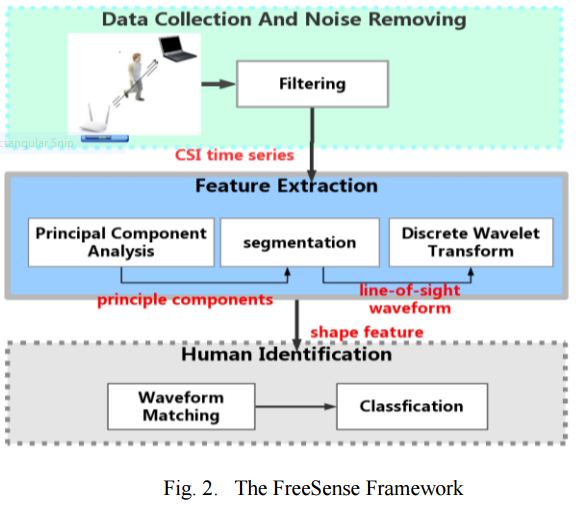Chinese researchers have developed a system called FreeSense that can be used to identify individuals using Wi-Fi signals.
FreeSense Is a Novel Approch to Human Identification Using Wi-Fi Signals
A new unique approach to human identification has been proposed by a Chinese team of researchers from the Northwestern Polytechnical University at Xian. They propose a new setup called FreeSense that uses Wi-Fi signals to enable non-intrusive identification of people in domestic environments. The idea is based on the team’s observation that each individual has specific influence patterns to the surrounding wireless signals while moving in confined spaces. This is regards to both body shape characteristics and motion patterns. This influence can be captured and analyzed using the Channel State Information (CSI) time series of the carrier Wi-Fi signals. A combination of the Principal Component Analysis (PCA), Discrete Wavelet Transformation (DWT) and the Dynamic Time Warping (DTW) techniques are used for this waveform-based identification.
In general human identification is based on ore more physiological or behavioural distinctions. They are related to body shape (fingerprint, iris, palm print or face characteristics) or behaviour patterns of the target individual such as his/her typing or voice rhythm. At the current moment the most successful and most popular methods involve fingerprint and iris identification. These two systems however have a requirement – the human has to be close to the sensing device so that the system can accurately check and ensure the proper identification.
Scientists worldwide are also working on developing methods for behavioural bio metrics using various equipment – radars, cameras or wearable devices. These vision approaches rely on line-of-sight coverage which is another major disadvantage.
Recently the Channel State Information (CSI) method has become available. This describes how the signal propagates from the transmitter to the receive and reflects the combined effects of the surrounding objects. There are many subcarriers that contain the information of attenuation and phase shift. This makes CSI a rich source of information about the variables in a given environment. This provides a very high-accuracy and quality method for human localisation and activity recognition. Crowd counting is also another option.

Further Information About the FreeSense Method
The FreeSense proposal faces two distinct technical challenges:
- Segmentation of identification condition settlement and CSI time series. This is linked to the fact that when a person moves around a certain location, such as a house, the influence level over the multi-path communication of the Wi-Fi signals can be different when people walk across different paths. It is relatively easy to understand that the identification performance can be raised and human-level Wi-Fi signal influence where the characteristics are easily distinguishable. The researchers need to find a better functional window that maximizes performance.
- Different people have different patterns when it comes to Wi-Fi signals based on their motion and body shapes. To perform effective human identification the methodology should reflect proper features that characterise the captured influences.
The Chinese team has made the following contributions to amend these issues:
- The use of FreeSense Wi-Fi CSI signals identification for non-obtrusive and privacy-preserving human identification
- The identification of line-of-sight (LOS) path crossing moments as the functional window for enhanced identification. The team has created an algorithm that segments the CSI time series for the extractions of the LOS waveforms within the window
- The use of a model that extracts the features of the LOS waveform, consisting of the PCA and DWT. The recognition is based on the difference of personal movement influence to Wi-Fi signals
FreeSense Demonstration and Test Results
The team used a Lenovo X200 laptop with the following characteristics:
- Intel Link 5300 WIFI Network Card
- 4 GB RAM
- The Ubuntu 14.04 Gnu/Linux distribution
The TP-Link TLWR1043ND router was used for the transmitter operating in 802.11n AP mode on the 2.4 GHz band. The chosen environment was a typical home. The receiver and the transmitter were placed on a distance of 250 centimeters. The CSI values were measures using standard ICMP ping packets send from the laptop using a data rate of 1000 packets per second.
9 people were recruited as volunteers for the experiment. The test achieves more than 88% accuracy with 6 subjects as family members. The overall detection rate is about 92.6%. Depending on different factors the accuracy may vary, however in general FreeSense proves to be a relatively good option. As this is still in early development, we may see further improvements and even industry adoption if this proves to be a reliable choice.
For more detailed information you can read the research paper titled “FreeSense:Indoor Human Identification with WiFi Signals” by downloading it from Arxiv.



